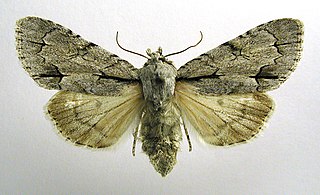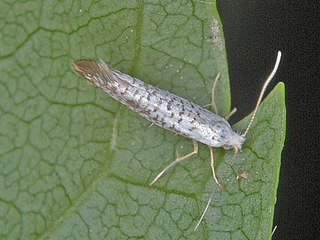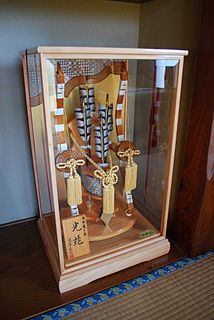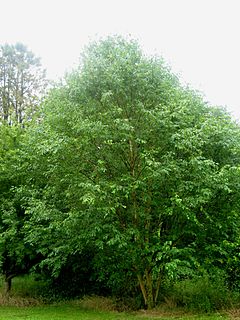| Look up white birch in Wiktionary, the free dictionary. |
White birch is a common name for Betula papyrifera , a species of tree native to northern North America.
White birch may also refer to:
| Look up white birch in Wiktionary, the free dictionary. |
White birch is a common name for Betula papyrifera , a species of tree native to northern North America.
White birch may also refer to:
| This disambiguation page lists articles associated with the title White birch. If an internal link led you here, you may wish to change the link to point directly to the intended article. |

A birch is a thin-leaved deciduous hardwood tree of the genus Betula, in the family Betulaceae, which also includes alders, hazels, and hornbeams. It is closely related to the beech-oak family Fagaceae. The genus Betula contains 30 to 60 known taxa of which 11 are on the IUCN 2011 Red List of Threatened Species. They are a typically rather short-lived pioneer species widespread in the Northern Hemisphere, particularly in northern areas of temperate climates and in boreal climates.

Betula pendula, commonly known as silver birch, warty birch, European white birch, or East Asian white birch, is a species of tree in the family Betulaceae, native to Europe and parts of Asia, though in southern Europe, it is only found at higher altitudes. Its range extends into Siberia, China, and southwest Asia in the mountains of northern Turkey, the Caucasus, and northern Iran. It has been introduced into North America, where it is known as the European white birch, and is considered invasive in some states in the United States and parts of Canada. The tree can also be found in more temperate regions of Australia.

Betula pubescens, commonly known as downy birch and also as moor birch, white birch, European white birch or hairy birch, is a species of deciduous tree, native and abundant throughout northern Europe and northern Asia, growing farther north than any other broadleaf tree. It is closely related to, and often confused with, the silver birch, but grows in wetter places with heavier soils and poorer drainage; smaller trees can also be confused with the dwarf birch.

Betula papyrifera is a short-lived species of birch native to northern North America. Paper birch is named for the tree's thin white bark, which often peels in paper like layers from the trunk. Paper birch is often one of the first species to colonize a burned area within the northern latitudes, and is an important species for moose browsing. The wood is often used for pulpwood and firewood.

Betula alleghaniensis, the yellow birch or golden birch, is a large and important lumber species of birch native to North-eastern North America. Its vernacular names refer to the color of the tree's bark. The name Betula lutea was used expansively for this tree but has now been replaced.

The dark dagger is a moth of the family Noctuidae. It is distributed throughout Europe, Turkey, the Near East, the European part of Russia, southern Siberia, the Ural, the Russian Far East, the Korean Peninsula, China and Japan (Hokkaido).

Birch sap,birch water or birch juice is the sap directly tapped from birch trees, Betula alba, Betula pendula, Betula lenta, Betula papyrifera, and Betula fontinalis.

Betula populifolia is a deciduous tree native to eastern North America.

Betula platyphylla, the Japanese white birch or Siberian silver birch, is a tree species belonging to the genus Betula. It can be found in temperate or subarctic places of Asia: Japan, China, Korea and Siberia. The Japanese White Birch can grow to be 20 m to 30 m tall.

Argyresthia retinella is a species of moth of the family Yponomeutidae.
Ectoedemia occultella, the small birch leafminer, is a moth of the family Nepticulidae. It has a Holarctic distribution. It is found in most of Europe, east through Russia to Japan. It is also present in North America. Mines very similar to that of Ectoedemia occultella have been found on Rosaceae species in Nepal and Japan and these may belong to this species.

Caloptilia betulicola, the red birch slender, is a moth of the family Gracillariidae. It is found from Scandinavia and the north of European Russia to the Pyrenees and Alps and from Ireland to Poland and Slovakia. In the east it is found up to China, Japan and the Russian Far East.

An azusa yumi (梓弓), is a sacred bow (yumi) used in certain Shinto rituals in Japan, as well as a Japanese musical bow, made from the wood of the Japanese azusa (梓) or Japanese cherry birch tree. Playing an azusa yumi forms part of some Shinto rituals; in Japan, it is universally believed that merely the twanging of the bowstring will frighten ghosts and evil spirits away from a house. In Japanese poetry, the word azusa yumi functions as a makurakotoba.

Betula grossa, commonly known as Japanese cherry birch, is a species of birch native to Japan, where it grows naturally in mixed woodland on hill and mountain slopes in Honshu, Shikoku, and Kyushu. It was introduced to the West in 1896, but remains rare in cultivation.